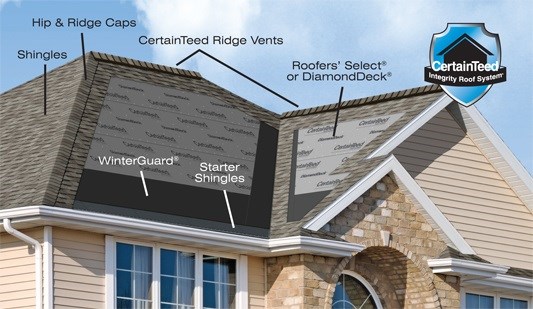
In the market for a new roof? While it may seem unnecessary, we believe it is critical to learn about the different roofing system components.
Why?
Because if you don’t know what your roof needs, you won’t be able to ensure your contractor is giving you a good roof.
Unfortunately, many roofing contractors skip replacing certain components of the roofing system in order to cut down on their costs. By educating yourself, you can guard against dishonest contractors.
Learn more about the different roofing system components below!
What are the components of a Residential Roofing System?
Residential roofing products include those products necessary to provide a quality roofing system. Roofers use these on homes, garages, and other residential buildings.
Generally, manufacturers design these products for steep slope applications.
Products can include roofing shingles, underlayment, and accessory products.
Roofing Shingles
CertainTeed manufactures high-quality asphalt roofing shingles in a wide variety of styles and colors. Asphalt roofing shingles are the most commonly used residential roofing product in the market. There are three major categories of roofing shingles. These include 3-tab shingles, architectural shingles, and premium shingles.
1.) 3-Tab
3-tab shingles are the most basic of residential roofing products available in the market.
They are single-layered roofing shingles that are generally designed to look like slate.
CertainTeed manufactures 3-tab shingles under the product name XT™ 25.
3-tab shingles are phasing out due to the growing popularity and value of architectural shingles.
However, some builders still use these shingles on new construction projects to cut down on costs.
Additionally, roofers will use them on repair projects or partial roof replacements to match a roof’s current shingles.
2.) Architectural
Architectural roofing shingles are heavier in weight than 3-tab roofing shingles. These are dual-layered or multi-layered in the case of CertainTeed’s tri-laminate technology.
Popular architectural shingles include CertainTeed’s Landmark series, Owen’s Corning Oakridge, and GAF’s Timberline series.
3.) Premium or Designer
Premium roofing shingles provide enhanced aesthetics and an increased design element. CertainTeed manufactures Grand Manor®, Presidential Shake® TL, and Carriage House®. They are commonly used as an affordable alternative to slate or cedar shake roofs (though still more expensive than architectural).
Check out our blog post on the different types of asphalt shingles to learn more.
Underlayment
Roofers install underlayment on residential roof decks as a water-resistant layer beneath roofing shingles. CertainTeed manufactures several utility-grade underlayment products including RoofRunner, DiamondDeck and WinterGuard.
CertainTeed’s WinterGuard acts as an extra thick waterproofing to prevent leaks from ice dams and wind-driven rain in vulnerable areas. Our roofers install this on the more vulnerable areas of a roofing system to add extra security.
Hip and Ridge
Accessory shingles are used to finish the hips and ridges of a residential roof. They carry the same warranty as the main shingles. There are a number of options designed to complement the appearance of shingles while providing the same level of protection and durability.
CertainTeed manufactures hip and ridge accessories under the product names ShadowRidge® and Mountain Ridge®.
Starter Shingles
Starter shingles save application time. These work specifically with different styles of shingles for consistent appearance and performance. CertainTeed manufactures starter shingles under the product names Swiftstart® to be used with the Landmark® series. They also manufacture a High-Performance Starter to go with the Grand Manor®, Highland Slate®, and Hatteras® shingles.
Flashing
Finally, you have flashing. Flashing is any type of material used to cover a water entry point where the shingles do not cover. This includes where the roof meets other areas of the house like the siding, chimney, or skylights. For these areas, roofing contractors install step flashing or apron flashing.
Apron flashing is used on horizontal areas where they can install one continuous strip of metal, whereas step flashing is comprised of small overlapping pieces of metal that can run along slopes.
The last type of flashing we want to cover are vent covers and roof boots. You can see these interspersed throughout your roofing system based one how your home was built. Vent covers usually look like small metal box coverings, while roof boots look like plungers that cover the PVC pipes.
Pro tip: When comparing roof replacement quotes, check to make sure the roofing contractor will replace all flashing.
By learning about your roofing system, you are equipping yourself to choose the best materials and contractor for the job! Want to learn more? Schedule a free roofing consult with one of our roofing experts!



